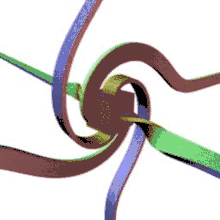Plate trick

In mathematics and physics, the plate trick, also known as Dirac's string trick, the belt trick, Balinese cup trick, is any of several demonstrations of the mathematical theorem that SU(2) (which double-covers SO(3)) is simply connected. To say that SU(2) double-covers SO(3) essentially means that the unit quaternions represent the group of rotations twice over.[1] In simple terms, rotating an object with strings attached by 360 degrees does not return the system to its original state, while a second rotation of 360 degrees, a total rotation of 720 degrees, does.[2]
Demonstrations
One way of doing the trick is to rest a small plate flat on the palm, then perform two rotations of one's hand while keeping the plate upright, ending in the original position. The hand makes one rotation passing over its shoulder, twisting the arm, and then another rotation passing under, untwisting it.
There is a Balinese candle dance,[3] where an open cup of liquid is held instead of a plate. Since the feet can remain fixed during the manoeuvre, but the hand rotates twice, and all the arm and shoulder and other body segments smoothly connect the feet to the hand and undergo the intermediate rotations, then the rotation loops that each segment undergoes are progressively collapsed as one progresses from the hand along the arm to the shoulder, torso, legs and finally the feet, which represent the collapse of the loop to a point, since they did not rotate. Similarly, for the belt version of the trick, the buckle rotates twice, but the opposite end of the belt remains fixed, and all along the rest of the belt are the progressively collapsing rotation loops from buckle to fixed end.
Figure-eight twirling used in baton twirling, staff twirling in martial arts, and swordsmanship, provides a similar demonstration. Here it is also fairly easy and natural to collapse the motion of the hand progressively down through a wiggle to a stationary position, providing an additional, and perhaps more intuitive demonstration that the double rotation loop can be collapsed to a point.
In mathematical physics, the trick illustrates the quaternionic mathematics behind the spin of spinors.[4] As with the plate trick, these particles' spins return to their original state only after two full rotations, not after one.
The belt trick

The same phenomenon can be demonstrated using a leather belt with an ordinary frame buckle, whose prong serves as a pointer. The end opposite the buckle is clamped so it cannot move. The belt is extended without a twist and the buckle is kept horizontal while being turned clockwise one complete turn (360°), as evidenced by watching the prong. The belt will then appear twisted, and no maneuvering of the buckle that keeps it horizontal and pointed in the same direction can undo the twist. Obviously a 360° turn counterclockwise would undo the twist. The surprise element of the trick is that a second 360° turn in the clockwise direction, while apparently making the belt even more twisted, does allow the belt to be returned to its untwisted state by maneuvering the buckle under the clamped end while always keeping the buckle horizontal and pointed in the same direction.[5]
Mathematically, the belt serves as a record, as one moves along it, of how the buckle was transformed from its original position, with the belt untwisted, to its final rotated position. The clamped end always represents the null rotation. The trick demonstrates that a path in rotation space (SO3) that produces a 360 degree rotation is not homotopy equivalent to a null rotation, but a path that produces a double rotation (720°) is null equivalent.[6]
In fiction
A fictional extension of the belt trick appears in Ian McEwan's novel Solar as a plot device to explain the protagonist's Nobel prize work.
References
- ↑ http://www.cis.upenn.edu/~cis610/geombchap8.pdf Retrieved September 9th, 2018
- ↑ https://arxiv.org/pdf/1001.1778.pdf retrieved September 6, 2018
- ↑ Pandanggo sa ilaw - Candle Dance
- ↑ https://www.quantamagazine.org/the-strange-numbers-that-birthed-modern-algebra-20180906/ Retrieved September 9 2018
- ↑ http://virtualmathmuseum.org/Surface/dirac-belt/DiracBelt.html Retrieved September 9 2018
- ↑ Understanding Quaternions and the Dirac Belt Trick, Mark Staley, 2010
- Bolker, Ethan D. (November 1973). "The Spinor Spanner". The American Mathematical Monthly. 80 (9): 977. doi:10.2307/2318771.
- Pengelley, David; Ramras, Daniel (2017-02-21). "How Efficiently Can One Untangle a Double-Twist? Waving is Believing!". The Mathematical Intelligencer: 1–14. arXiv:1610.04680. doi:10.1007/s00283-016-9690-x. ISSN 0343-6993.
See also
External links
- Animation of the Dirac belt trick, including the path through SU(2)
- Animation of the Dirac belt trick, with a double belt
- Animation of the extended Dirac belt trick, showing that spin 1/2 particles are fermions: they can be untangled after switching particle positions twice, but not once
- Air on the Dirac Strings, showing the belt trick with several belts attached to a spherical particle, by Louis Kauffman and colleagues
- Video of Balinese cup trick
- The Dirac String Trick
- The double-tipping nullhomotopy